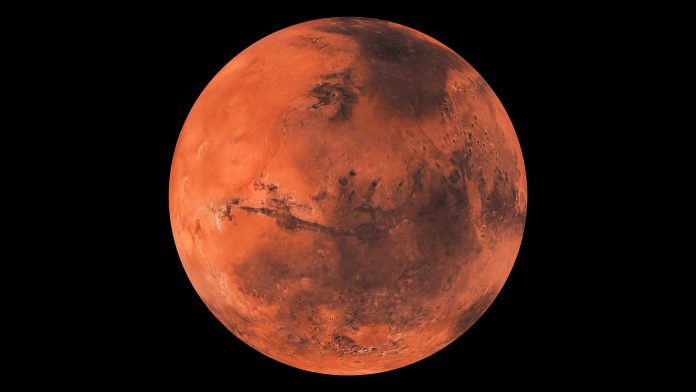Using data gathered from earthquakes detected on Mars, NASA’s InSight Mission team have been able to unravel the internal structure of Mars.
Today, three papers have been published which comprise co-authors from French institutions and laboratories, including the CNRS, the Institut de Physique du Globe de Paris, and Université de Paris, with vital support from the French space agency CNES and the French National Research Agency ANR.
The result of the research has been that, for the first time ever, it has been possible to approximate the size of Mars’s core, as well as the thickness of its crust and the structure of its mantle, based on the analysis of seismic waves reflected and modified by interfaces in its interior.
These novel findings mark the first ever seismic exploration of the internal structure of a terrestrial planet other than Earth and represent an essential step towards identifying the formation and thermal evolution of Mars.
The information utilised for these groundbreaking findings was collected from around 12 earthquakes on Mars that were detected by the Very Broad Band SEIS seismometer, which was developed in France.
NASA’s InSight mission
Before the InSight mission, the internal structure of Mars was not well understood, with models founded only on information gathered from orbiting satellites and on the analysis of Martian meteorites that fell to Earth.
Based on gravity and topographical data alone, the thickness of the crust was anticipated to be between 30 and 100 km. Meanwhile, values of the planet’s moment of inertia and density indicated a core with a radius of 1,400 to 2,000 km. However, the comprehensive internal structure of Mars and the depth of the boundaries between the crust, mantle, and core were entirely undetermined.
With the fruitful deployment of the SEIS experiment on Mars’ surface in early 2019, the mission scientists amassed and analysed seismic data over one Martian year, which is approximately two Earth years.
Gathering multiple findings from a single station
One challenge of studying Mars is its low seismicity and the seismic noise generated by its atmosphere. Earthquakes on Earth are much stronger and seismometers are more efficiently placed in vaults or underground, making it feasible to acquire an exact image of the planet’s interior. Consequently, particular consideration had to be given to the data from Mars.
“But although Martian earthquakes have a relatively low magnitude, less than 3.5, the very high sensitivity of the VBB sensor combined with the very low noise at nightfall enabled us to make discoveries that, two years ago, we thought were only possible with earthquakes with a magnitude greater than 4,” explained Philippe Lognonné, a Professor at the University of Paris and the Principal Investigator for the SEIS instrument at IPGP.
Each day, the data, processed by CNES, IPGP and CNRS, and transferred to the scientists, was carefully cleaned of ambient noise – such as wind and deformation related to rapid temperature changes. The international Mars Quake Service team (MQS) recorded the seismic events on a daily basis: more than 600 have now been catalogued, of which over 60 were caused by relatively distant earthquakes. Around ten of the latter comprise data about the planet’s deep structure.
“The direct seismic waves from an earthquake are a bit like the sound of our voices in the mountains: they produce echoes. And it was these echoes, reflected off the core, or at the crust-mantle interface or even the surface of Mars, that we looked for in the signals, thanks to their similarity to the direct waves,” Lognonné said.
By comparing the behaviour of seismic waves as they travelled through the crust before reaching the InSight station, several discontinuities in the crust were identified: the first, observed at a depth of about 10 km, marks the boundary between a highly altered structure, resulting from circulation of fluid a very long time ago, and crust that is only slightly altered. A second discontinuity around 20 km down, and a third, less pronounced one at around 35 km, shed light on the stratification of the crust beneath InSight: “To identify these discontinuities, we used all the most recent analytical methods, both with earthquakes of tectonic origin and with vibrations caused by the environment (seismic noise),” says Benoit Tauzin, Senior Lecturer at the University of Lyon and a researcher at LGL-TPE.
Using only a single station, the scientists were able to ascertain the structure of the upper mantle, and in particular the variation in seismic velocities with depth. However, such variations in velocity are related to temperature.
“That means we can estimate the heat flow of Mars, which is probably three to five times lower than the Earth’s, and place constraints on the composition of the Martian crust, which is thought to contain over half the heat-producing radioactive elements present in the planet,” commented Henri Samuel, a CNRS researcher at IPGP.
Finally, for the third study, the team searched for waves reflected off the surface of the Martian core, the measurement of whose radius was one of the main achievements of the InSight mission. “To do this,” explained Mélanie Drilleau, a research engineer at ISAE-SUPAERO, “we tested several thousand mantle and core models against the phases and signals observed.”
They discovered an excess of energy for cores with a radius between 1,790 km and 1,870 km. Such a large size suggests the existence of light elements in the liquid core and has massive implications for the mineralogy.
New discoveries lead to new questions
Over two years of seismic monitoring has led to the first model of the internal structure of Mars, going all the way down to the core. With this, Mars joins the Earth and the Moon as a terrestrial body whose deep structures have been explored by seismologists.
With these incredible new findings, new questions and future areas of study materialise, such as: is the alteration of the top 10 km of crust general, or is it limited to the InSight landing zone? What impact will these first models have on theories of the formation and thermal evolution of Mars, in particular for the first 500 million years when Mars had liquid water on its surface and intense volcanic activity?
In order to answer these exciting questions, the InSight mission has been extended for a further two years and the extra electrical power acquired after the productive cleaning of its solar panels carried out by JPL. New data is expected to strengthen and enhance these models.









